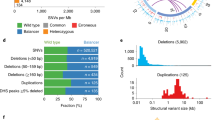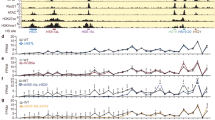Abstract
The developmental regulation of vertebrate Hox gene transcription relies on the interplay between local and long-range controls. To study this complex genomic organization, we designed a strategy combining meiotic and targeted recombinations to induce large chromosomal rearrangements in vivo without manipulating embryonic stem cells. With this simple approach (called STRING), we engineered a large 7-cM inversion, which split the Hoxd cluster into two independent pieces. Expression analyses showed a partition of global enhancers, allowing for their precise topographic allocation on either side of the cluster. Such a functional organization probably contributed to keeping these genes clustered in the course of vertebrate evolution. This approach can be used to study the relationship between genome architecture and gene expression, such as the effects of genome rearrangements in human diseases or during evolution.
This is a preview of subscription content, access via your institution
Access options
Subscribe to this journal
Receive 12 print issues and online access
$209.00 per year
only $17.42 per issue
Buy this article
- Purchase on Springer Link
- Instant access to full article PDF
Prices may be subject to local taxes which are calculated during checkout





Similar content being viewed by others
References
Hurst, L.D., Pal, C. & Lercher, M.J. The evolutionary dynamics of eukaryotic gene order. Nat. Rev. Genet. 5, 299–310 (2004).
Kleinjan, D.A. & van Heyningen, V. Long-range control of gene expression: emerging mechanisms and disruption in disease. Am. J. Hum. Genet. 76, 8–32 (2005).
Lettice, L.A. et al. A long-range Shh enhancer regulates expression in the developing limb and fin and is associated with preaxial polydactyly. Hum. Mol. Genet. 12, 1725–1735 (2003).
Spitz, F., Gonzalez, F. & Duboule, D. A global control region defines a chromosomal regulatory landscape containing the HoxD cluster. Cell 113, 405–417 (2003).
Zuniga, A. et al. Mouse limb deformity mutations disrupt a global control region within the large regulatory landscape required for Gremlin expression. Genes Dev. 18, 1553–1564 (2004).
Spitz, F. et al. Large scale transgenic and cluster deletion analysis of the HoxD complex separate an ancestral regulatory module from evolutionary innovations. Genes Dev. 15, 2209–2214 (2001).
Duboule, D. Vertebrate Hox gene regulation: clustering and/or colinearity? Curr. Opin. Genet. Dev. 8, 514–518 (1998).
Akam, M. Hox and HOM: homologous gene clusters in insects and vertebrates. Cell 57, 347–349 (1989).
Yu, Y. & Bradley, A. Engineering chromosomal rearrangements in mice. Nat. Rev. Genet. 2, 780–790 (2001).
Zakany, J., Gerard, M., Favier, B. & Duboule, D. Deletion of a HoxD enhancer induces transcriptional heterochrony leading to transposition of the sacrum. EMBO J. 16, 4393–4402 (1997).
Gimond, C. et al. Cre-loxP-mediated inactivation of the alpha6A integrin splice variant in vivo: evidence for a specific functional role of alpha6A in lymphocyte migration but not in heart development. J. Cell Biol. 143, 253–266 (1998).
Wittig, B.M., Johansson, B., Zoller, M., Schwarzler, C. & Gunthert, U. Abrogation of experimental colitis correlates with increased apoptosis in mice deficient for CD44 variant exon 7 (CD44v7). J. Exp. Med. 191, 2053–2064 (2000).
Kmita, M., Fraudeau, N., Herault, Y. & Duboule, D. Serial deletions and duplications suggest a mechanism for the collinearity of Hoxd genes in limbs. Nature 420, 145–150 (2002).
Kmita, M., Kondo, T. & Duboule, D. Targeted inversion of a polar silencer within the HoxD complex re-allocates domains of enhancer sharing. Nat. Genet. 26, 451–454 (2000).
Davis, A.P., Witte, D.P., Hsieh-Li, H.M., Potter, S.S. & Capecchi, M.R. Absence of radius and ulna in mice lacking Hoxa-11 and Hoxd-11. Nature 375, 791–795 (1995).
Sordino, P., van der Hoeven, F. & Duboule, D. Hox gene expression in teleost fins and the origin of vertebrate digits. Nature 375, 678–681 (1995).
Duboule, D. & Dolle, P. The structural and functional organization of the murine HOX gene family resembles that of Drosophila homeotic genes. EMBO J. 8, 1497–1505 (1989).
Graham, A., Papalopulu, N. & Krumlauf, R. The murine and Drosophila homeobox gene complexes have common features of organization and expression. Cell 57, 367–378 (1989).
Gaunt, S.J., Sharpe, P.T. & Duboule, D. Spatially restricted domains of homeo-gene transcripts in mouse embryos: relation to a segmented body plan. Development 104 Suppl, 169–179 (1988).
Gould, A., Morrison, A., Sproat, G., White, R.A. & Krumlauf, R. Positive cross-regulation and enhancer sharing: two mechanisms for specifying overlapping Hox expression patterns. Genes Dev. 11, 900–913 (1997).
Zhang, F. et al. Elements both 5′ and 3′ to the murine Hoxd4 gene establish anterior borders of expression in mesoderm and neurectoderm. Mech. Dev. 67, 49–58 (1997).
Vogels, R., Charite, J., de Graaff, W. & Deschamps, J. Proximal cis-acting elements cooperate to set Hoxb-7 (Hox-2.3) expression boundaries in transgenic mice. Development 118, 71–82 (1993).
Zheng, B., Sage, M., Sheppeard, E.A., Jurecic, V. & Bradley, A. Engineering mouse chromosomes with Cre-loxP: range, efficiency, and somatic applications. Mol. Cell. Biol. 20, 648–655 (2000).
Puech, A. et al. Normal cardiovascular development in mice deficient for 16 genes in 550 kb of the velocardiofacial/ DiGeorge syndrome region. Proc. Natl. Acad. Sci. USA 97, 10090–10095 (2000).
Kondo, T., Zakany, J. & Duboule, D. Control of colinearity in AbdB genes of the mouse HoxD complex. Mol. Cell 1, 289–300 (1998).
Herault, Y., Rassoulzadegan, M., Cuzin, F. & Duboule, D. Engineering chromosomes in mice through targeted meiotic recombination (TAMERE). Nat. Genet. 20, 381–384 (1998).
Monge, I., Kondo, T. & Duboule, D. An enhancer-titration effect induces digit-specific regulatory alleles of the HoxD cluster. Dev. Biol. 256, 212–220 (2003).
Kulnane, L.S., Lehman, E.J.H., Hock, B.J., Tsuchiya, K.D. & Lamb, B.T. Rapid and efficient detection of transgene homozygosity by FISH of mouse fibroblasts. Mamm. Genome 13, 223–226 (2002).
Spitz, F. et al. A t(2;8) balanced translocation with breakpoints near the human HOXD complex causes mesomelic dysplasia and vertebral defects. Genomics 79, 493–498 (2002).
Acknowledgements
We thank A. Sonnenberg, U. Gunthert, J. Zakany and J. Cobb for gifts of mice and advice for genotyping; G. Zacchetti for in situ probes; F. Chabaud for help with mouse fibroblasts; C. Hinard for the chromosome FISH analysis; and J. Zakany for comments on this manuscript. This work was supported by funds from the canton de Genève, the Claraz and Louis-Jeantet foundations, the Swiss National Research Fund, the National Center for Competence in Research 'Frontiers in Genetics' and the European Union programmes 'Eumorphia' and 'Cells to Organs'.
Author information
Authors and Affiliations
Corresponding author
Ethics declarations
Competing interests
The authors declare no competing financial interests.
Supplementary information
Supplementary Table 1
Sequences of primers used to genotype the different alleles. (PDF 53 kb)
Rights and permissions
About this article
Cite this article
Spitz, F., Herkenne, C., Morris, M. et al. Inversion-induced disruption of the Hoxd cluster leads to the partition of regulatory landscapes. Nat Genet 37, 889–893 (2005). https://doi.org/10.1038/ng1597
Received:
Accepted:
Published:
Issue Date:
DOI: https://doi.org/10.1038/ng1597
This article is cited by
-
Giant lungfish genome elucidates the conquest of land by vertebrates
Nature (2021)
-
Mesomelic dysplasias associated with the HOXD locus are caused by regulatory reallocations
Nature Communications (2021)
-
HOX gene cluster (de)regulation in brain: from neurodevelopment to malignant glial tumours
Cellular and Molecular Life Sciences (2020)
-
Large scale genomic reorganization of topological domains at the HoxD locus
Genome Biology (2017)
-
Efficient and rapid generation of large genomic variants in rats and mice using CRISMERE
Scientific Reports (2017)



